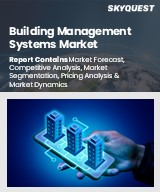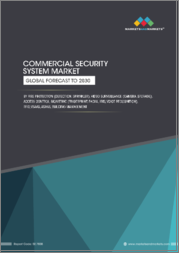
|
시장보고서
상품코드
1676119
세계의 빌딩 관리 시스템 시장 보고서 : 산업 분석, 규모, 점유율, 성장, 동향 및 예측(2025-2033년)Global Building Management System Market Report- Industry Analysis, Size, Share, Growth, Trends and Forecast 2025 to 2033 |
||||||
세계의 빌딩 관리 시스템 시장 규모는 2024년 27억 7,000만 달러에서 2033년 90억 7,000만 달러에 달하고, 2026-2033년의 예측 기간 동안 14.06%의 견고한 연평균 성장률(CAGR)을 나타낼 것으로 예상됩니다.
빌딩 관리 시스템(BMS) 시장은 에너지 효율적이고 스마트한 빌딩 솔루션에 대한 수요가 지속적으로 증가함에 따라 크게 성장하고 있으며, BMS 기술은 HVAC, 조명, 보안, 에너지 관리 등 다양한 빌딩 시스템을 중앙 집중식으로 제어하고 모니터링할 수 있도록 합니다. 가능하게 합니다. 지속가능성, 운영 효율성, 거주자의 편안함에 대한 관심이 높아지면서 BMS 솔루션에 대한 투자가 촉진되고 시장 확대가 더욱 가속화되고 있습니다. 기업들이 건물 성능의 최적화와 운영 비용 절감을 위해 노력하면서 빌딩 관리 시스템 시장은 번창할 것으로 예상됩니다.
기술 발전은 빌딩 관리 시스템 시장의 미래를 형성하는 데 중요한 역할을 하고 있으며, IoT, 인공지능, 데이터 분석의 혁신은 BMS 솔루션의 기능을 강화하여 예지보전, 실시간 모니터링, 자동 제어를 가능하게 하고 있습니다. 또한, 스마트 센서와 디바이스의 통합은 빌딩 운영의 효율성을 높이고 전반적인 사용자 경험을 향상시키고 있습니다. 제조업체들이 혁신적인 새로운 솔루션을 지속적으로 개발함에 따라, 빌딩 관리 시스템 시장은 다양한 상업용 및 주거용 용도에서 채택이 확대될 것으로 예상됩니다.
또한, 규제 준수와 지속가능성에 대한 관심이 높아지면서 빌딩 관리 시스템 시장의 성장 궤도에 영향을 미치고 있습니다. 각국 정부가 보다 엄격한 에너지 효율 기준과 지속가능성 이니셔티브를 시행함에 따라 컴플라이언스를 지원하고 환경에 미치는 영향을 줄이는 BMS 솔루션에 대한 수요가 증가할 것으로 예상됩니다. 이러한 추세에 따라 기술 제공업체와 건물 소유주는 산업 표준 및 모범 사례에 부합하는 통합 솔루션을 개발하기 위해 협력하고 있습니다. 시장이 계속 진화함에 따라 기술, 지속가능성, 규제 준수 통합이 성공의 중요한 촉진제가 될 것으로 보입니다.
당사의 보고서는 고객에게 다양한 산업 및 시장에 대한 종합적이고 실용적인 통찰력을 제공하기 위해 세심하게 작성되었습니다. 각 보고서는 시장 상황을 완전히 이해하기 위해 몇 가지 중요한 요소를 포함하고 있습니다.
시장 개요 : 정의, 분류, 산업 현황 등 시장에 대한 자세한 소개.
시장 성장 촉진요인: 시장 성장에 영향을 미치는 주요 촉진요인, 억제요인, 시장 성장 촉진요인 및 과제를 상세하게 분석합니다. 이 섹션에서는 기술 발전, 규제 변화, 새로운 트렌드 등의 요인을 검토합니다.
세분화 분석 : 제품 유형, 용도, 최종 사용자, 지역 등의 기준에 따라 시장을 명확한 부문으로 분류합니다. 이 분석을 통해 각 부문의 성과와 잠재력을 파악할 수 있습니다.
경쟁상황: 시장 점유율, 제품 포트폴리오, 전략적 이니셔티브, 재무실적 등 주요 시장 진입기업에 대한 종합적인 평가. 주요 기업들이 채택하고 있는 경쟁 역학 및 주요 전략에 대한 고찰이 포함되어 있습니다.
시장 예측 : 과거 데이터와 현재 시장 상황을 바탕으로 일정 기간 동안 시장 규모와 성장 추세를 예측합니다. 여기에는 정량적 분석과 미래 시장 궤적을 나타내는 그래프 표시가 포함됩니다.
지역 분석 : 지역별 시장 성과를 평가하고 주요 시장 및 지역 동향을 파악할 수 있습니다. 지역 시장 역학 및 비즈니스 기회를 이해하는 데 도움이 됩니다.
새로운 트렌드와 기회: 현재 시장 동향과 새로운 시장 동향, 기술 혁신, 잠재적 투자 대상 부문을 식별합니다. 미래 시장 개척 및 성장 전망에 대한 통찰력을 제공합니다.
목차
제1장 서문
제2장 주요 요약
- 시장 하이라이트
- 세계 시장 현황
제3장 빌딩 관리 시스템 산업 분석
- 서론 : 시장 역학
- 시장 성장 촉진요인
- 시장 성장 억제요인
- 기회
- 산업 동향
- Porter의 Five Forces 분석
- 시장의 매력 분석
제4장 밸류체인 분석
- 밸류체인 분석
- 원료 분석
- 원료 리스트
- 원료 제조업체 리스트
- 주요 원료 가격 동향
- 잠재적 바이어 리스트
- 마케팅 채널
- 직접 마케팅
- 간접 마케팅
- 마케팅 채널 발전 동향
제5장 세계의 빌딩 관리 시스템 시장 분석 : 구성요소별
- 구성요소별 개요
- 구성요소별 과거 및 예측 데이터 분석
- 하드웨어
- 소프트웨어
- 서비스
제6장 세계의 빌딩 관리 시스템 시장 분석 : 유형별
- 유형별 개요
- 유형별 과거 및 예측 데이터 분석
- 스탠드얼론 BMS
- 통합형 BMS
- IoT 기반 BMS
제7장 세계의 빌딩 관리 시스템 시장 분석 : 시스템 유형별
- 시스템 유형별 개요
- 시스템 유형별 과거 및 예측 데이터 분석
- HVAC 시스템
- 화재 및 안전
- 에너지 관리
- 보안 및 입퇴실 관리
- 스마트 빌딩 통합
- 시설 관리 시스템
- 긴급사태 관리
- 기타
제8장 세계의 빌딩 관리 시스템 시장 분석 : 전개 형태별
- 전개 형태별 개요
- 전개 형태별 과거 및 예측 데이터 분석
- 온프레미스
- 클라우드 기반
제9장 세계의 빌딩 관리 시스템 시장 분석 : 최종 용도별
- 최종 용도별 개요
- 최종 용도별 과거 및 예측 데이터 분석
- 상업 빌딩
- 산업용 빌딩
- 주택용 빌딩
제10장 세계의 빌딩 관리 시스템 시장 분석 : 지역별
- 지역별 전망
- 서론
- 북미의 판매 분석
- 개요, 분석과 예측
- 북미 : 부문별
- 북미 : 국가별
- 미국
- 캐나다
- 멕시코
- 유럽의 판매 분석
- 개요, 분석과 예측
- 유럽 : 부문별
- 유럽 : 국가별
- 영국
- 프랑스
- 독일
- 이탈리아
- 러시아
- 기타 유럽
- 아시아태평양의 판매 분석
- 개요, 분석과 예측
- 아시아태평양 : 부문별
- 아시아태평양 : 국가별
- 중국
- 인도
- 일본
- 한국
- 호주
- 동남아시아
- 기타 아시아태평양
- 라틴아메리카의 판매 분석
- 개요, 분석과 예측
- 라틴아메리카 : 부문별
- 라틴아메리카 : 국가별
- 브라질
- 아르헨티나
- 페루
- 칠레
- 기타 라틴아메리카
- 중동 및 아프리카의 판매 분석
- 개요, 분석과 예측
- 중동 및 아프리카 : 부문별
- 중동 및 아프리카 : 국가별 리스트
- 사우디아라비아
- 아랍에미리트(UAE)
- 이스라엘
- 남아프리카공화국
- 기타 중동 및 아프리카
제11장 빌딩 관리 시스템 기업 경쟁 구도
- 빌딩 관리 시스템 시장 경쟁
- 제휴, 협엄 및 계약
- 인수합병(M&A)
- 신제품 발표
- 기타 개발
제12장 기업 개요
- 주요 기업의 시장 점유율 분석
- 시장 집중도
- ABB Ltd.
- Beckhoff Automation GmbH & Co. KG
- Bosch Thermotechnology Corporation
- BuildingIQ Inc.
- Carrier Global Corporation
- Crestron Electronics Inc.
- Delta Controls Inc.
- Emerson Electric Co.
- Honeywell International Inc.
- Johnson Controls International Plc.
- Legrand SA
- Mitsubishi Electric Corporation
- Schneider Electric SE
- Siemens AG
- Trane Technologies Plc
Global Building Management System Market size is anticipated to grow from USD 2.77 Billion in 2024 to USD 9.07 Billion by 2033, showcasing a robust Compound Annual Growth Rate (CAGR) of 14.06% during the forecast period of 2026 to 2033.
The Building Management System (BMS) Market is experiencing significant growth as the demand for energy-efficient and smart building solutions continues to rise. BMS technology enables the centralized control and monitoring of various building systems, including HVAC, lighting, security, and energy management. The increasing focus on sustainability, operational efficiency, and occupant comfort is driving investments in BMS solutions, further propelling market expansion. As organizations seek to optimize building performance and reduce operational costs, the market for building management systems is expected to flourish.
Technological advancements are playing a crucial role in shaping the future of the building management system market. Innovations in IoT, artificial intelligence, and data analytics are enhancing the capabilities of BMS solutions, enabling predictive maintenance, real-time monitoring, and automated control. Additionally, the integration of smart sensors and devices is improving the efficiency of building operations and enhancing the overall user experience. As manufacturers continue to innovate and develop new solutions, the building management system market is likely to see increased adoption across various commercial and residential applications.
Moreover, the growing emphasis on regulatory compliance and sustainability is influencing the building management system market's growth trajectory. As governments implement stricter energy efficiency standards and sustainability initiatives, the demand for BMS solutions that support compliance and reduce environmental impact is expected to rise. This trend is driving collaboration between technology providers and building owners to develop integrated solutions that align with industry standards and best practices. As the market continues to evolve, the integration of technology, sustainability, and regulatory compliance will be key drivers of success.
Our reports are meticulously crafted to provide clients with comprehensive and actionable insights into various industries and markets. Each report encompasses several critical components to ensure a thorough understanding of the market landscape:
Market Overview: A detailed introduction to the market, including definitions, classifications, and an overview of the industry's current state.
Market Dynamics: In-depth analysis of key drivers, restraints, opportunities, and challenges influencing market growth. This section examines factors such as technological advancements, regulatory changes, and emerging trends.
Segmentation Analysis: Breakdown of the market into distinct segments based on criteria like product type, application, end-user, and geography. This analysis highlights the performance and potential of each segment.
Competitive Landscape: Comprehensive assessment of major market players, including their market share, product portfolio, strategic initiatives, and financial performance. This section provides insights into the competitive dynamics and key strategies adopted by leading companies.
Market Forecast: Projections of market size and growth trends over a specified period, based on historical data and current market conditions. This includes quantitative analyses and graphical representations to illustrate future market trajectories.
Regional Analysis: Evaluation of market performance across different geographical regions, identifying key markets and regional trends. This helps in understanding regional market dynamics and opportunities.
Emerging Trends and Opportunities: Identification of current and emerging market trends, technological innovations, and potential areas for investment. This section offers insights into future market developments and growth prospects.
SEGMENTATION COVERED IN THE REPORT
By Component
- Hardware
- Software
- Services
By Type
- Standalone BMS
- Integrated BMS
- IoT-based BMS
By System Type
- HVAC System
- Fire and Safety
- Energy Management
- Security and Access Control
- Smart Building Integration
- Facility Management System
- Emergency Management
- Others
By Deployment
- On-premises
- Cloud-based
By End-use
- Commercial Building
- Industrial Building
- Residential Building
- COMPANIES PROFILED
- ABB Ltd.
- Beckhoff Automation GmbH & Co. KG
- Bosch Thermotechnology Corporation
- BuildingIQ Inc.
- Carrier Global Corporation
- Crestron Electronics Inc.
- Delta Controls Inc.
- Emerson Electric Co.
- Honeywell International Inc.
- Johnson Controls International Plc.
- Legrand SA
- Mitsubishi Electric Corporation
- Schneider Electric SE
- Siemens AG
- Trane Technologies plc
- The above list can be customized.
TABLE OF CONTENTS
1. PREFACE
- 1.1. Report Description
- 1.1.1 Objective
- 1.1.2 Target Audience
- 1.1.3 Unique Selling Proposition (USP) & offerings
- 1.2. Research Scope
- 1.3. Research Methodology
- 1.3.1 Market Research Process
- 1.3.2 Market Research Methodology
2. EXECUTIVE SUMMARY
- 2.1. Highlights of Market
- 2.2. Global Market Snapshot
3. BUILDING MANAGEMENT SYSTEM INDUSTRY ANALYSIS
- 3.1. Introduction - Market Dynamics
- 3.2. Market Drivers
- 3.3. Market Restraints
- 3.4. Opportunities
- 3.5. Industry Trends
- 3.6. Porters Five Force Analysis
- 3.7. Market Attractiveness Analysis
- 3.7.1 Market Attractiveness Analysis By Component
- 3.7.2 Market Attractiveness Analysis By Type
- 3.7.3 Market Attractiveness Analysis By System Type
- 3.7.4 Market Attractiveness Analysis By Deployment
- 3.7.5 Market Attractiveness Analysis By End-use
- 3.7.6 Market Attractiveness Analysis By Region
4. VALUE CHAIN ANALYSIS
- 4.1. Value Chain Analysis
- 4.2. Raw Material Analysis
- 4.2.1 List of Raw Materials
- 4.2.2 Raw Material Manufactures List
- 4.2.3 Price Trend of Key Raw Materials
- 4.3. List of Potential Buyers
- 4.4. Marketing Channel
- 4.4.1 Direct Marketing
- 4.4.2 Indirect Marketing
- 4.4.3 Marketing Channel Development Trend
5. GLOBAL BUILDING MANAGEMENT SYSTEM MARKET ANALYSIS BY COMPONENT
- 5.1. Overview By Component
- 5.2. Historical and Forecast Data Analysis By Component
- 5.3. Hardware Historic and Forecast Sales By Regions
- 5.4. Software Historic and Forecast Sales By Regions
- 5.5. Services Historic and Forecast Sales By Regions
6. GLOBAL BUILDING MANAGEMENT SYSTEM MARKET ANALYSIS BY TYPE
- 6.1. Overview By Type
- 6.2. Historical and Forecast Data Analysis By Type
- 6.3. Standalone BMS Historic and Forecast Sales By Regions
- 6.4. Integrated BMS Historic and Forecast Sales By Regions
- 6.5. IoT-based BMS Historic and Forecast Sales By Regions
7. GLOBAL BUILDING MANAGEMENT SYSTEM MARKET ANALYSIS BY SYSTEM TYPE
- 7.1. Overview By System Type
- 7.2. Historical and Forecast Data Analysis By System Type
- 7.3. HVAC System Historic and Forecast Sales By Regions
- 7.4. Fire and Safety Historic and Forecast Sales By Regions
- 7.5. Energy Management Historic and Forecast Sales By Regions
- 7.6. Security and Access Control Historic and Forecast Sales By Regions
- 7.7. Smart Building Integration Historic and Forecast Sales By Regions
- 7.8. Facility Management System Historic and Forecast Sales By Regions
- 7.9. Emergency Management Historic and Forecast Sales By Regions
- 7.10. Others Historic and Forecast Sales By Regions
8. GLOBAL BUILDING MANAGEMENT SYSTEM MARKET ANALYSIS BY DEPLOYMENT
- 8.1. Overview By Deployment
- 8.2. Historical and Forecast Data Analysis By Deployment
- 8.3. On-premises Historic and Forecast Sales By Regions
- 8.4. Cloud-based Historic and Forecast Sales By Regions
9. GLOBAL BUILDING MANAGEMENT SYSTEM MARKET ANALYSIS BY END-USE
- 9.1. Overview By End-use
- 9.2. Historical and Forecast Data Analysis By End-use
- 9.3. Commercial Building Historic and Forecast Sales By Regions
- 9.4. Industrial Building Historic and Forecast Sales By Regions
- 9.5. Residential Building Historic and Forecast Sales By Regions
10. GLOBAL BUILDING MANAGEMENT SYSTEM MARKET ANALYSIS BY GEOGRAPHY
- 10.1. Regional Outlook
- 10.2. Introduction
- 10.3. North America Sales Analysis
- 10.3.1 Overview, Historic and Forecast Data Sales Analysis
- 10.3.2 North America By Segment Sales Analysis
- 10.3.3 North America By Country Sales Analysis
- 10.3.4 United States Sales Analysis
- 10.3.5 Canada Sales Analysis
- 10.3.6 Mexico Sales Analysis
- 10.4. Europe Sales Analysis
- 10.4.1 Overview, Historic and Forecast Data Sales Analysis
- 10.4.2 Europe By Segment Sales Analysis
- 10.4.3 Europe By Country Sales Analysis
- 10.4.4 United Kingdom Sales Analysis
- 10.4.5 France Sales Analysis
- 10.4.6 Germany Sales Analysis
- 10.4.7 Italy Sales Analysis
- 10.4.8 Russia Sales Analysis
- 10.4.9 Rest Of Europe Sales Analysis
- 10.5. Asia Pacific Sales Analysis
- 10.5.1 Overview, Historic and Forecast Data Sales Analysis
- 10.5.2 Asia Pacific By Segment Sales Analysis
- 10.5.3 Asia Pacific By Country Sales Analysis
- 10.5.4 China Sales Analysis
- 10.5.5 India Sales Analysis
- 10.5.6 Japan Sales Analysis
- 10.5.7 South Korea Sales Analysis
- 10.5.8 Australia Sales Analysis
- 10.5.9 South East Asia Sales Analysis
- 10.5.10 Rest Of Asia Pacific Sales Analysis
- 10.6. Latin America Sales Analysis
- 10.6.1 Overview, Historic and Forecast Data Sales Analysis
- 10.6.2 Latin America By Segment Sales Analysis
- 10.6.3 Latin America By Country Sales Analysis
- 10.6.4 Brazil Sales Analysis
- 10.6.5 Argentina Sales Analysis
- 10.6.6 Peru Sales Analysis
- 10.6.7 Chile Sales Analysis
- 10.6.8 Rest of Latin America Sales Analysis
- 10.7. Middle East & Africa Sales Analysis
- 10.7.1 Overview, Historic and Forecast Data Sales Analysis
- 10.7.2 Middle East & Africa By Segment Sales Analysis
- 10.7.3 Middle East & Africa By Country Sales Analysis
- 10.7.4 Saudi Arabia Sales Analysis
- 10.7.5 UAE Sales Analysis
- 10.7.6 Israel Sales Analysis
- 10.7.7 South Africa Sales Analysis
- 10.7.8 Rest Of Middle East And Africa Sales Analysis
11. COMPETITIVE LANDSCAPE OF THE BUILDING MANAGEMENT SYSTEM COMPANIES
- 11.1. Building Management System Market Competition
- 11.2. Partnership/Collaboration/Agreement
- 11.3. Merger And Acquisitions
- 11.4. New Product Launch
- 11.5. Other Developments
12. COMPANY PROFILES OF BUILDING MANAGEMENT SYSTEM INDUSTRY
- 12.1. Top Companies Market Share Analysis
- 12.2. Market Concentration Rate
- 12.3. ABB Ltd.
- 12.3.1 Company Overview
- 12.3.2 Company Revenue
- 12.3.3 Products
- 12.3.4 Recent Developments
- 12.4. Beckhoff Automation GmbH & Co. KG
- 12.4.1 Company Overview
- 12.4.2 Company Revenue
- 12.4.3 Products
- 12.4.4 Recent Developments
- 12.5. Bosch Thermotechnology Corporation
- 12.5.1 Company Overview
- 12.5.2 Company Revenue
- 12.5.3 Products
- 12.5.4 Recent Developments
- 12.6. BuildingIQ Inc.
- 12.6.1 Company Overview
- 12.6.2 Company Revenue
- 12.6.3 Products
- 12.6.4 Recent Developments
- 12.7. Carrier Global Corporation
- 12.7.1 Company Overview
- 12.7.2 Company Revenue
- 12.7.3 Products
- 12.7.4 Recent Developments
- 12.8. Crestron Electronics Inc.
- 12.8.1 Company Overview
- 12.8.2 Company Revenue
- 12.8.3 Products
- 12.8.4 Recent Developments
- 12.9. Delta Controls Inc.
- 12.9.1 Company Overview
- 12.9.2 Company Revenue
- 12.9.3 Products
- 12.9.4 Recent Developments
- 12.10. Emerson Electric Co.
- 12.10.1 Company Overview
- 12.10.2 Company Revenue
- 12.10.3 Products
- 12.10.4 Recent Developments
- 12.11. Honeywell International Inc.
- 12.11.1 Company Overview
- 12.11.2 Company Revenue
- 12.11.3 Products
- 12.11.4 Recent Developments
- 12.12. Johnson Controls International Plc.
- 12.12.1 Company Overview
- 12.12.2 Company Revenue
- 12.12.3 Products
- 12.12.4 Recent Developments
- 12.13. Legrand SA
- 12.13.1 Company Overview
- 12.13.2 Company Revenue
- 12.13.3 Products
- 12.13.4 Recent Developments
- 12.14. Mitsubishi Electric Corporation
- 12.14.1 Company Overview
- 12.14.2 Company Revenue
- 12.14.3 Products
- 12.14.4 Recent Developments
- 12.15. Schneider Electric SE
- 12.15.1 Company Overview
- 12.15.2 Company Revenue
- 12.15.3 Products
- 12.15.4 Recent Developments
- 12.16. Siemens AG
- 12.16.1 Company Overview
- 12.16.2 Company Revenue
- 12.16.3 Products
- 12.16.4 Recent Developments
- 12.17. Trane Technologies Plc
- 12.17.1 Company Overview
- 12.17.2 Company Revenue
- 12.17.3 Products
- 12.17.4 Recent Developments



















